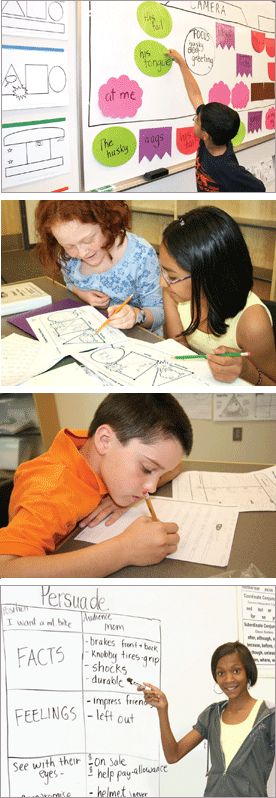ALL Six Components of Writing
Writing Alive’s comprehensive curriculum shows teachers how to integrate ALL six components of writing into weekly writing lessons, ensuring there are no gaps in skill instruction. As a result, schools do not need to supplement instruction with other programs, saving them money and time. Teachers have the tools they need to begin instruction immediately. 1. Structures of Language – With modeling and explicit instruction, students learn to construct simple, compound, complex and compound-complex sentence structures using colorful sentence component shapes. As a result students communicate more clearly in speaking and writing and can tackle reading higher level texts. 2. Grammar – Each Monday teachers instruct a new language, grammar or writer’s craft skill engaging multiple learning channels. Throughout the week that skill is practiced in daily speaking, writing, sentence styling and revision. Grammar skills follow a prescribed scope and sequence at each grade level. 3. Process – Instruction begins with the sentence, teaching it with hands-on sentence shapes to help students understand the components and importance of sentence structures in reading and writing. Students build their writing to paragraphs, compositions, stories and essays. Teachers and students follow Writing Alive’s Guided Interactive Writing Process weekly. 4. Modes and Genres – Teachers model how to analyze fiction and nonfiction genres. Students organize their thoughts in brainstormers and planners for narrative, informative, explanative, opinion, analytical and argument writing. Since students learn to write from models, Writing Alive provides weekly writing models, editorials and articles in the genres in which they will write. Each week begins with a suggested mentor text. Students learn to use their writing skills across the curriculum. |
All six components are implemented every day as prescribed in the Day by Day Curriculum Guide, so success is immediate and sustained for both English and ELL students.
5. Traits – Daily Sentence Styling gives students opportunities to master revision strategies that improve organization, ideas, content, word choice, voice, fluency, style and conventions. Explicit instruction and models equip students to personalize and improve the traits in their writing. 6. Assessment – Growth is intentional! Students view basic, proficient and advanced writing models, set goals on diagnostic rubrics before drafting and assess goals after drafting to guide their revision. Students celebrate success as they graph their scores and take ownership of their writing progress! |


